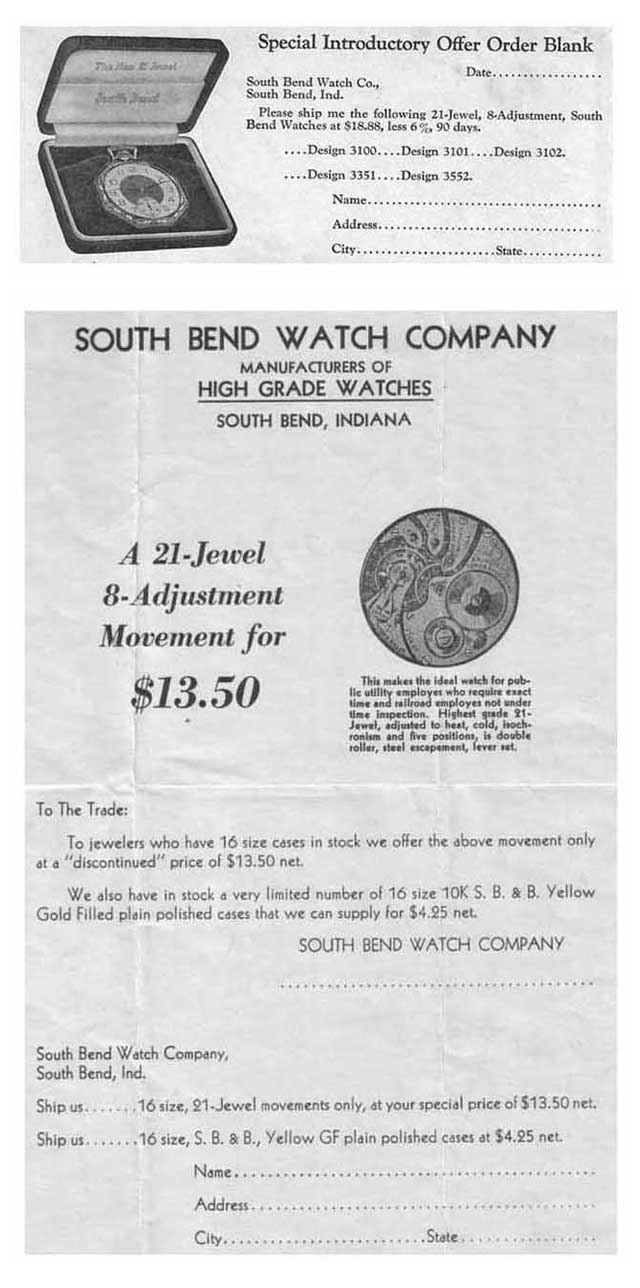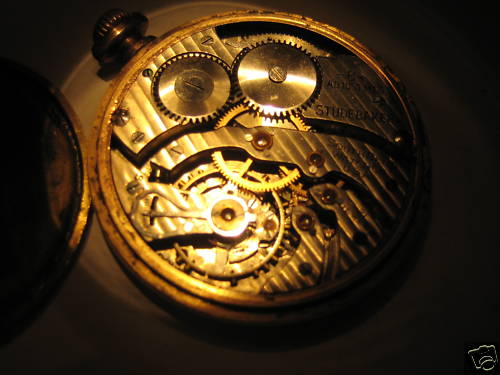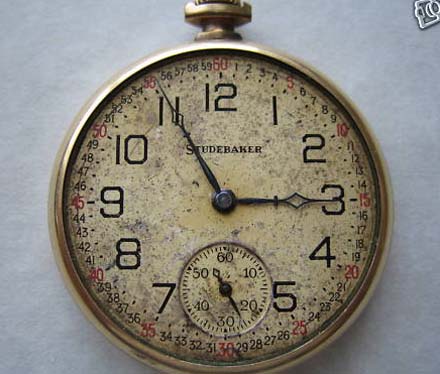
| WWT Shows | CLICK TO: Join and Support Internet Horology Club 185™ | IHC185™ Forums |

|
• Check Out Our... • • TWO Book Offer! • |
Welcome Aboard IHC185™  Internet Horology Club 185
Internet Horology Club 185  IHC185™ Discussion Site Main Page
IHC185™ Discussion Site Main Page  Open to the World RESEARCH FORUMS
Open to the World RESEARCH FORUMS  South-Bend Watch Company Research Forum
South-Bend Watch Company Research Forum  Odd Combination 12s Studebaker
Odd Combination 12s Studebaker
 Internet Horology Club 185
Internet Horology Club 185  IHC185™ Discussion Site Main Page
IHC185™ Discussion Site Main Page  Open to the World RESEARCH FORUMS
Open to the World RESEARCH FORUMS  South-Bend Watch Company Research Forum
South-Bend Watch Company Research Forum  Odd Combination 12s Studebaker
Odd Combination 12s StudebakerGo  | New Topic  | Find-Or-Search  | Notify  | Tools  | Reply to Post  |  |
Just wanted to share a South Bend Studebaker I picked up recently. The part I find interesting on this Studebaker is that the original box (The movement and case numbers match the numbers on the inside of the box) that came with it does not mention that it is a Studebaker at all! It does mention it as a 21 Jewel, 8 Adjustment South Bend watch. Also note that the dial looks to be original and is also marked as South Bend only. I believe that this watch has something to do with the article posted in the South Bend Library of information under the Studebaker section, Highest Grade 21-Jewel Watch (No Studebaker!). While the movement is marked "studebaker", I believe the rest of the watch speaks for itself as being the 21 Jewel South Bend talked about in the advertisement. The case seems to be the same as shown in the article also. Any Feedback on this would be appreciated! Jared | |||
|
Pic 2 of 4 | ||||
|
Pic 3 of 4 | ||||
|
Last Pic | ||||
|
Jared: Thanks for posting this. Now you are muddying up the waters again. A few years ago I had a conversation with George Reitenour, a desendant of the Studebaker Family who has a lot of the original documentation on South Bend watches. He thought at that time that it was possible to obtain a Studebaker watch with a South Bend dial from the factory. After more research etc. we came to the conclusion that it was remotely possible but highly unlikely that that would happen. Therefore we believed that all Studebaker watches with South Bend dials and all South Bend watches with Studebaker dials had been the victim of a dial switch. Your find is very interesting but still possible that the dial had been switch. Too bad they didn't put the movement numbers on the dials. I would like to hear Lindell's and Frank's take on this find. | ||||
|
| IHC President Life Member |
I have long held with the... "remotely possible but highly unlikely" ...part of your second paragraph Ernie, my immediate thought that some of those sent off to retailers, usually considered to be "Jewelers from Chicago" in that sad period after the company failed at the end of 1929 were put likely together like the example Jared recently discovered. We have for some time wondered about how they were configured and this along with paperwork previously posted may well be the answer to a question that we as South-Bend collectors have toyed with over the years. We are painfully aware the use of "South-Bend" on these Mail-Order Studebaker movements caused a lot of problems with retail jewelers through the 1920s and it stands to reason the liquidators would have reverted to using the "South-Bend" name by combining leftover "Studebaker" watch movements with leftover "South-Bend" dials and leftover "South-Bend" boxes in order to unload what had by then become highly distressed merchandise. But remember, no records were kept, the company history became landfill One more point, we know there were a few watches sold as "Studebaker Junior" and those were left-over South-Bend movements with metal "Studebaker" dials. Essentially the same thing in reverse. They were just selling watches, back then nobody cared about these fine points we obsess about as modern-day collectors and archivists. Good looking watch Jared, thanks a million for sharing it with all of us! Lindell | |||
|
| IHC Life Member South-Bend |
It's becoming a fairly well known fact that at the end, probably when the company was in receivership, that 21j movements were sold with SB dials. Here's two ads from that time period.  | |||
|
According to the South Bend Data Base, Jared's watch was made in mid run (estimate by serial number placement) 1927. 1929 was the last year of production for this watch. South Bend Watch Company closed its doors sometime in 1929. That is two years after Jared's watch was made. When left-over watches were assembled by liquidators, what is the likelihood that a 1927 movement would have been in the lot? However, if the struggling company was trying to reduce Studebaker inventory by selling these 1927 movements to dealers with South Bend dials I would think we would find lower production figures in 1928 and 1929. Therefore, my guess is that liquidator assembled Studebaker watches with South Bend dials would occur more with watches from the 1929 run than we would we find with earlier runs. We do know for sure that there are examples there are Studebaker watches from earlier production runs that have South Bend dials. These we have always said were victims of dial switches. However, in light of the information Frank provided with the Dealer ads, when did South Bend start offering Studebaker Watches with South Bend dials to the dealer (jeweler) market? Did they start this at the beginning of the mail order watches or toward the end 1929? Also, how prevalent was this practice? | ||||
|
| IHC President Life Member |
Ernie, Think of it this way, when watches or other components were placed into the vault at the end of every work day the most recently finished would have been placed in front of those previously finished. As they were taken out the newest merchandise was actually sold first. That means as they went deeper into the vault they came to the older items. This is true of every watch company, not just South-Bend and we must always remember... "They were not selling milk, butter, eggs or even bread." In other words there was no "expiration date" on watches and if they got into really old merchandise, a little oil here and a drop of oil there... well, you see what I mean. In fact, I have Hamilton and Ball-Hamilton examples that I can prove sat in the Hamilton vault for a long, long time. It is altogether reasonable to conclude the South-Bend liquidation began soon after the end of 1929 as the depression hit and desperation set-in. We can only imagine what it was like to dump watches at less than cost of production just to raise money for the creditors. All had been going well until that time and the end came rather suddenly. The liquidation involved more than just 12-size "Mail-Order Studebaker" watches, look at the second ad Frank posted above that is apparently a South-Bend Grade 227 Railroad movement in the illustration. It is likely that at some point we may be so fortunate as to find something such as a letter or other mailing with an actual date on it, that will help our understanding enormously. We have been piecing it together for quite a while already and that day will come. Which leads to two more points, we really do not know the finish dates on South-Bend watch movements, any listing of movements with dates is made up of pure conjecture. None of the records remain, as stated previously more than eighty years after the fact we are left to our best guesses and suppositions. We must also realize, although it looks right, we have no way to prove that Jared's watch is the one that came with the box we see it in. And finally, without at least some documentation such as found with Jared's watch, collectors will always prefer an example where everything appears to match, having to "explain" the possibilities of originality will always confuse the issue at time of sale. I have a couple that look "wrong" and may be "right" but without proof all I have is a "maybe this" or "maybe that" watch. The story is a work in progress and we learn a little more every day. "And the beat goes on!" Lindell | |||
|
Lindell: Thanks for your take on this. As I was writing my comments above I had no intention, what so ever, to disagree or debate what you had said in your previous comment. I simply wanted to express some questions I had and give my take on a brief analysis of what we know so far and to raise points of thought for further discussion. I agree we still don't have a complete story. I doubt that we ever will. We have a lot of information today and we know a lot about the history, but there is perhaps much more that we don't know. I agree that time will tell, hopefully in our time. I wonder how many movements were in the vault when South Bend Watch Co. closed their doors. How old were the movements they had to liquidate? This raises another question. We know that South Bend started using metal painted dials between 1915 and 1920. Yet we find older South Bend Watches with painted metal dials. We also know that the grade 315 was made until 1919 so it is possible they SB Watch Co. could have used painted dials on them. Perhaps if some other size 18 watches with older dated movements were also lying in the vault they got metal dials to get them out the door also? I think this proves that what we hold to be fact may indeed have some exceptions. The problem we face is being able to identify the exceptions and what the factory did to rectify it. Then we have to ask, were they always consistent? | ||||
|
| IHC President Life Member |
Ernie, You ask if they were always consistent... They were always, always, always 100% consistent in one thing and one thing only. THEIR INCONSISTENCY!!! None of the various watch companies I have studied kept the kinds of records we would prefer and none of them produced their movements in chronological order. The deeper you take it the more frustrated you will become, they did whatever it took to sell watches, they paid no attention to all these fine points we so obsess about... and nobody obsesses over the fine points more than yours truly... I love this hobby dearly but it can be really frustrating! We also have to consider the passage of time, how many dials were replaced or refinished, how many movements were re-cased, sometimes these things happened over and over. The vast majority of watches we find did not begin as we see them today. The best correlation is with cars, another passion you and I share. Show me a truly original car, and I mean not altered in any way, a truly stone-stock factory original... you see what I mean. Our new Jeep has just over 1,000 miles on it and I have already changed a few things. The question you raised about metal dials is interesting. When the folks at South-Bend began producing 12-size watches the earliest ones likely had porcelain dials. Later the metal dials with designs became popular so they were phased-in and porcelain dials on 12-size became a thing of the past. But they still had some of the early, harder to sell movements and eventually they were marketed. We have every reason to believe they sold some of the earliest ones a decade or so after they were originally finished. That causes a movement we perceive as being from about 1910-12 era found in a 1920s style case and fronting a 1920s style dial and likely be original. On 18-size movements, a painted dial could have been used as early as 1910 or as late as the early 1920s and be original to the movement. (It could have also been changed as recently yesterday afternoon, believe me, some resellers change watch components like we change our socks!) Likewise we find 16-size movements with metal dials were available from around 1910 until the end of production at the time of the 1929 crash, and of course they were used on post-production examples during the 1930 liquidation we have been discussing in this topic. Some of it we have sorted out but there is so much we will never know for sure! Be well my friend, Lindell | |||
|
Lindell: Having been an analyst, by training and occupation, for 29 years I want everything to be absolute and the exceptions to be identifiable and predictable. Of coarse that never happened in real life working for the state so why should it be with watches where they didn’t have the political interference the one experiences in civil service. So, we just move on and record and record and analyze and then start over later down the road as more insight surfaces. | ||||
|
I just aquired what I think is a Studebaker 12s model 1, 21j, movement serial number 1076396, c1924. Picture is not good but I think it emulates Jareds aforementioned 21j South Bend Dialed, Studebaker / South Bend movement. It has a numerical dial that I want to be enamel, but is probably metal. I don't have possesion of the watch yet. I bought it because of the historical value. I would like to know if my watch is worth restoration.  | ||||
|
Here is the dial. The case is engraved with a masonic symbol & a name. 14k  | ||||
|
I thought about buying that Studebaker, but decided to wait for the 299 selling a little bit afterwards Jared | ||||
|
Jared When I received the watch, upon inspection the back cover as well as the frame threads were cross threaded. With the watch lying flat, the side of the case actually smiled at me. It looked like some handy-man tried to pry the caseback off. Looked like a pickle jar top pried up with a bottle opener. It worked but that pickle jar will never seal properly again! The damage could not be seen in the ebay photos. The seller had a no return policy! The seller would not take the watch back. I took drastic action & found that eBay Buyer Protection really works. It took them a month to solve the problem, but I got my money back, including the shipping cost. Kinda restores my faith in consumer protection. | ||||
|
| Powered by Social Strata |
| Your request is being processed... |
|
©2002-2025 Internet Horology Club 185™ - Lindell V. Riddle President - All Rights Reserved Worldwide

